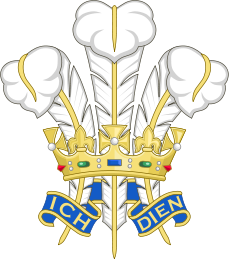Land Rover
 |
|
| Type | Private Unlimited Company |
|---|---|
| Industry | Automotive |
| Founded | 1978 (established by BL as a subsidiary[1]) |
| Founder(s) | British Leyland |
| Headquarters | Gaydon, Warwickshire, England, United Kingdom |
| Key people | Ratan Tata, Chairman Ralf Speth, CEO Phil Popham, Managing Director |
| Products | Automobiles |
| Owner(s) | Tata Motors |
| Employees | 13,000 |
| Parent | Jaguar Land Rover |
| Website | LandRover.com |
| Owner | Tata Motors |
|---|---|
| Country | United Kingdom |
| Markets | Automotive |
| Previous Owners | 1948–1967 Rover Company 1967–1968 Leyland Motor Corporation 1968–1986 British Leyland Motor Corporation 1986–1988 Rover Group 1988–1994 British Aerospace 1994–2000 BMW 2000–2008 Ford Motor Company |
Land Rover is currently a luxury-type four-wheel drive, all-terrain vehicle manufacturer, based in Gaydon, Warwickshire, England. It operates as the Jaguar Land Rover business unit by Tata Motors of India.[2]
Originally the term Land Rover referred to one specific vehicle (see Land Rover Series), a pioneering civilian all-terrain utility vehicle launched on 30 April 1948, at the Amsterdam Motor Show, but was later used as a brand for several distinct four-wheel drive models.
Starting out as a model in the Rover Company's product range, the Land Rover brand developed, first as a marque, then as a separate company, developing a range of four-wheel drive capable vehicles under a succession of owners, including British Leyland, British Aerospace, and BMW. In 2000, the company was sold by BMW to the Ford Motor Company, becoming part of their Premier Automotive Group. In June 2008, Ford sold its Jaguar and Land Rover operations to Tata Motors.[3][4][5]
Land Rover, coming in second to Jeep, is one of the longest surviving four-wheel drive (4WD) brands.
Contents |
History
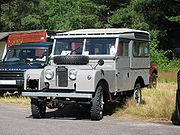

The first Land Rover was designed in 1948 in the United Kingdom (on the island of Anglesey off the coast of Wales) by Maurice Wilks, chief designer at the British car company Rover on his farm in Newborough, Anglesey.[6] It is said that he was inspired by an American World War II Jeep that he used one summer at his holiday home in Wales. The first Land Rover prototype, later nicknamed 'Centre Steer', was built on a Jeep chassis. A distinctive feature is their bodies, constructed of a lightweight rustproof proprietary alloy of aluminium and magnesium called Birmabright. This material was used because of the post-war steel shortage and the plentiful supply of post-war aircraft aluminium. This metal's resistance to corrosion was one of the factors that allowed the vehicle to build up a reputation for longevity in the toughest conditions. Land Rover once advertised that 75% of all vehicles ever built are still in use. In fact, Land Rover drivers sometimes refer to other makes of 4x4 as "disposables".[7] The early choice of colour was dictated by military surplus supplies of aircraft cockpit paint, so early vehicles only came in various shades of light green; all models until recently feature sturdy box section ladder-frame chassis.
The early vehicles, such as the Series I, were field-tested at Long Bennington and designed to be field-serviced; advertisements for Rovers cite vehicles driven thousands of miles on banana oil. Now with more complex service requirements this is less of an option. The British Army maintains the use of the mechanically simple 2.5 litre 4-cylinder 300TDi engined versions rather than the electronically controlled 2.5 litre 5-cylinder TD5 to retain some servicing simplicity. This engine also continued in use in some export markets using units built at a Ford plant in Brazil, where Land Rovers were built under license and the engine was also used in Ford pick-up trucks built locally. Production of the TDi engine ended in the United Kingdom in 2006, meaning that Land Rover no longer offers it as an option. International Motors of Brazil offer an engine called the 2.8 TGV Power Torque, which is essentially a 2.8 litre version of the 300TDi, with a corresponding increase in power and torque. All power is combined with an All-Terrain Traction Control which gives active terrain response; Ferrari uses a similar system in race traction.
During its ownership by Ford, Land Rover was associated with Jaguar. In many countries they shared a common sales and distribution network (including shared dealerships), and some models shared components and production facilities.
Sale to Tata
On 11 June 2007, Ford Motor Company announced its plan to sell Land Rover, along with Jaguar. Ford retained the services of Goldman Sachs, Morgan Stanley and HSBC to advise it on the details of the deal. The buyer was initially expected to be announced by September 2007, but the sale was delayed and an announcement was not made until March 2008. A UK-based private equity firm, Alchemy Partners, Tata Motors and Mahindra and Mahindra (both from India) expressed interest in purchasing Jaguar and Land Rover from the Ford Motor Company.[8][9]
Before the sale was announced, Anthony Bamford, chairman of British excavators manufacturer JCB, had expressed interest in purchasing Jaguar Cars in August, the year previously;[10] only to back out when told the sale would also involve Land Rover, which he did not wish to buy. [11] Tata Motors received endorsements from the Transport and General Workers' Union (TGWU)-Amicus[12] combine and Ford as a preferred bidder.[13]
On 26 March 2008, Ford announced that it had agreed to sell its Jaguar and Land Rover operations to Tata Motors, and that the sale was expected to be completed by the end of the second quarter of 2008.[3] On 2 June 2008, the sale to Tata Motors was completed by both parties.[5] Included in the deal were the rights to three other British brands: Jaguar's own Daimler, as well as two dormant brands Lanchester and Rover.[14] BMW and Ford had previously retained ownership of the Rover brand to protect the integrity of the Land Rover brand, with which 'Rover' might be confused in the US 4x4 market; the Rover brand was originally used under license by MG Rover until it collapsed in 2005, at which point it was re-acquired by the then Ford Motor Company owned Land Rover Limited.
Timeline

- 1948: Land Rover is designed by the Wilks Brothers and is manufactured by the Rover Car Company
- 1948: the Land Rover Series 1 was launched at the Amsterdam motor show
- 1958: Series II launched
- 1961: Series IIA began production
- 1967: Rover becomes part of Leyland Motors Ltd, later British Leyland (BL) as Rover Triumph.
- 1970: Introduction of the Range Rover
- 1971: Series III launched.
- 1975: BL collapses and is nationalised, publication of the Ryder Report recommends that Land Rover be split from Rover and be treated as a separate company within BL and becomes part of the new commercial vehicle division called the Land Rover Leyland Group
- 1976: One-millionth Land Rover leaves the production line.
- 1978: Land Rover Limited formed as a separate subsidiary of British Leyland[15]
- 1980: Rover car production ends at Solihull with the transfer of SD1 production to Cowley, Oxford; Solihull is now exclusively for Land Rover manufacture. 5-door Range Rover introduced.
- 1983: Land Rover 90 (Ninety)/110 (One-Ten)/127 (renamed Defender in 1990) introduced.
- 1986: BL plc becomes Rover Group plc; Project Llama started.
- 1988: Rover Group is privatised and becomes part of British Aerospace, and is now known simply as Rover.
- 1987: Range Rover is introduced to the U.S market March 16.
- 1989: Introduction of the Discovery
- 1994: Rover Group is taken over by BMW. Introduction of second-generation Range Rover. (The original Range Rover was continued under the name 'Range Rover Classic' until 1995)
- 1997: Land Rover introduces the Special Edition Discovery XD with AA Yellow paint, subdued wheels, SD type roof racks, and a few other off-road upgrades directly from the factory. Produced only for the North American market, the Special Vehicles Division of Land Rover created only 250 of these bright yellow SUV's. Official formation of the Camel Trophy Owners Club by co-founders Neill Browne, Pantelis Giamarellos and Peter Sweetser.
- 1997: Introduction of the Freelander
- 1998: Introduction of the second generation of Discovery
- 2000: BMW breaks up the Rover Group and sells Land Rover to Ford for £1.8 billion[16]
- 2002: Introduction of third-generation Range Rover
- 2005: Land Rover 'founder' Rover, collapses under the ownership of MG Rover Group.
- 2004: Introduction of the third-generation Discovery/LR3
- 2005: Introduction of Range Rover Sport
- 2005: Adoption of the Jaguar AJ-V8 engine to replace the BMW M62 V8 in the Range Rover
- 2006: Announcement of a new 2.4 litre diesel engine, 6-speed gearbox, dash and forward facing rear seats for Defender. Introduction of second generation of Freelander (Freelander 2). Ford acquires the Rover trademark from BMW, who previously licensed its use to MG Rover Group.
- 8 May 2007: 4,000,000th Land Rover rolls off the production line, a Discovery 3 (LR3), donated to The Born Free Foundation.
- 12 June 2007: Announcement from the Ford Motor Company that it plans to sell Land Rover and also Jaguar Cars.
- August 2007: India's Tata Motors and Mahindra and Mahindra as well as financial sponsors Cerberus Capital Management, TPG Capital and Apollo Management expressed their interest in purchasing Jaguar Cars and Land Rover from the Ford Motor Company.[17]
- 26 March 2008: Ford agreed to sell their Jaguar Land Rover operations to Tata Motors.[3]
- 2 June 2008:Tata Motors finalised their purchase of Jaguar and Land Rover from Ford.[5]
Manufacturing
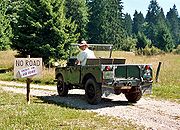
Land Rovers were manufactured primarily at the Solihull plant, near Birmingham, but production of the "Freelander" (2) was moved to the Jaguar car factory at Halewood near Liverpool, a former Ford car plant. Defender models are assembled under licence in several locations worldwide, including Spain (Santana Motors), Iran (Pazhan Morattab), Brazil (Karmann)and Turkey (Otokar).[18] The former BL/Rover Group technical centre at Gaydon in Warwickshire is home to the corporate and R&D headquarters.
In May 2010, Tata Motors announced that it plans to build Land Rovers (as well as Jaguar cars) in China as the company seeks to cut costs and expand sales.[19] Tata will also close one of the two facilities in England (Castle Bromwich, where the Jaguar XJ and XK cars are assembled, and Solihull, where Land Rovers are built) to consolidate production on one more efficient facility.[19]
Models

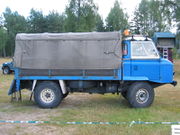
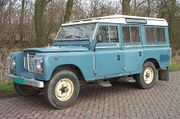
Historic
- Series I, II and III - the original 4x4
- Range Rover Classic - the original Range Rover, produced from 1970 to 1996
Current
| 2008 UK Land Rover Model Line-up | ||
| Model | Type | Price Range |
|---|---|---|
| Land Rover Defender | Light Utility 4x4 vehicle | £22,480–£28,495 |
| Freelander 2 | Compact 4x4 | £25,935–£33,990 |
| Discovery 4 | Mid-size 4x4 | £28,915–£48,720 |
| Range Rover | Full-size 4x4 | £58,695–£84,900 |
| Range Rover Sport | Full-size 4x4 | £35,665–£63,225 |
| 2010 US Land Rover Model Line-up | ||
| Model | Type | Price Range |
|---|---|---|
| Land Rover LR2 | Compact SUV | $31,000–$36,000 |
| Land Rover LR4 | Mid-size SUV | $50,000–$58,000 |
| Range Rover | Full-size SUV | $81,850–$125,000 |
| Range Rover Sport | Full-size SUV | $60,500–$79,200 |
At the 2004 North American International Auto Show, Land Rover introduced its first concept, the Range Stormer (Gritzinger, 2004). A "green" concept known as Land e was also shown.
Military
Models developed for the UK Ministry of Defence (MoD) include:
- 101 Forward Control - also known as the "Land Rover One Tonne"
- 1/2 ton Lightweight - airportable military short wheelbase from the Series 2a
- Land Rover Wolf - an uprated Military Defender
- SNATCH Land Rover - Land Rover with composite armoured body in UK Armed Forces Service
- 109 Series IIa and III ambulance (body by Marshalls of Cambridge)
- Range Rover '6x6' Fire Appliance (conversion by Carmichael and Sons of Worcester) for RAF airfield use
- 130 Defender ambulance
- 'Llama' prototypes for 101 replacement.
Engines
During the history of the Land Rover many different engines have been fitted.
- The inlet-over-exhaust petrol engines ("semi side-valve"), in both four and six cylinder variants, which were used for the very first Land Rovers in 1948, and which had their origins in pre-war Rover cars. Cubic capacity of the first models was 1600cc.
- The four cylinder overhead valve engines, both petrol and diesel, which first appeared (in diesel form) in 1957, at the tail end of Series One production, and evolved over the years to the 300 TDi turbodiesel, which remains in production today for some overseas markets.
- The Buick-sourced all aluminium Rover V8 motor.
- 1,997 cc Petrol, inlet-over-exhaust: Series I engine, carried over for the first few months of Series II production.
- 2,052 cc Diesel, overhead valve: Land Rover's first diesel engine, and one of the first small high-speed diesels produced in the UK. It appeared in 1957, and was used in Series II production until 1961. Looks almost identical to the later 2,286 cc engine, but many internal differences. It produced 51 bhp (38 kW).
- 2,286 cc Petrol, overhead valve, 3 bearing crank:
- 2,286 cc Diesel, overhead valve, 3 bearing crank: Appeared in 1961 alongside the redesigned 2,286 cc petrol engine at the start of Series IIA production, and shared its cylinder block and some other components. It produced 62 bhp (46 kW).
- 2,625 cc Petrol, inlet-over-exhaust: Borrowed from the Rover saloon range, in response to demands from mid-Sixties Land Rover users for more power and torque.
- 2,286 cc petrol/diesel, overhead valve type 11J: 5 bearing crank: In 1980, Land Rover finally did something about the crank failures which had plagued its four cylinder engines for 22 years. These engines lasted beyond the end of Series III production and into the first couple of years of the new Ninety and One Ten ranges.
- 3,528 cc V8 Petrol: The ex-Buick all alloy V8 engine appeared in the Range Rover right from the start of production in 1970, but did not make its way into the company's utility vehicles until 1979.
- 2,495 cc petrol, overhead valve: The final development of Land Rover's ohv petrol 'four', with hardened valve seats which allow running on unleaded (or LPG).
- 2,495 cc diesel, overhead valve, type 12J: Land Rover reworked the old 'two and a quarter' diesel for the Eighties. The injection pump was driven off a toothed belt at the front of the engine (together with the camshaft), a change compared with the older diesels.
- 2,495 cc turbodiesel, overhead valve, type 19J
- 2,495 cc turbodiesel, overhead valve, 200TDi and 300TDi: Used in the Defender and Discovery from 1990. The cylinder block was similar to the previous engine, although strengthened internally with an aluminium ladder frame bolted to the bearing caps, but the cylinder head was all-new and a direct injection fuel system was used.
- 2,495 cc turbodiesel, 5-cylinder, TD5: An all-new engine for the second generation Discovery, and this also found its way into the Defender. The TD5 features electronic control of the fuel injection system (with a control unit under the driver's seat), 'drive by wire' throttle and other refinements, all aimed at minimising exhaust emissions.
- The Freelander was available with various Rover K-series engines.
Electric vehicles
Integrated Electric Rear Axle Drive (ERAD) technology, dubbed e-terrain technology,[20] will allow the vehicle to move off without starting the engine as well as supplying extra power over tough terrain.[20] Land Rover’s Diesel ERAD Hybrid was developed as part of a multi-million-pound project supported by the UK Government’s Energy Saving Trust, under the low carbon research and development programme. ERAD programme is one of a broad range of sustainability-focused engineering programmes that Land Rover is pursuing, brought together by the company under the collective name e TERRAIN Technologies.[21]
Land Rover has presented in the 2008 London Motor Show its new ERAD diesel-electric hybrid in a pair of Freelander 2 (LR2) prototypes. The new hybrid system is being designed as a scalable and modular system that could be applied across a variety of Land Rover models and powertrains.[22]
Land Rover unveiled the LRX hybrid concept at the North American International Auto Show in Detroit, for it to be going into production.[23] An ERAD will enable the car to run on electric power at speeds below 20 mph (32 km/h).[24]
Abilities
The use of Land Rovers by the British and Commonwealth military, as well as on long term civilian projects and expeditions, is mainly due to the marque's off-road performance. For example, the short wheelbase version of the Land Rover Defender is capable of tackling a gradient of 45 degrees, an approach angle of up to 50 degrees, a departure angle of 53 degrees and a ramp break-over of up to 25 degrees. A feature of all Land Rover products has been their axle articulation (the degree to which the wheels have vertical travel, with allowing them to maintain contact with the ground over uneven surfaces), which is currently 7 inch (178 mm) at the front axle and 8.25 inch (210 mm) at the rear on basic Defender models. While developing more car-like, road-orientated models over years, Land Rover markets all its vehicles as fully off-road capable- including the Range Rover, which is equipped with a two-speed transfer box and long-travel suspension, as well as an array of electronic aids such as Land Rover's 'Terrain Response' system and traction control. The drivetrain and structure is capable of off-roading in all conditions as well as a towing loads of up to 4 tons.
Power take-off (PTO) was integral to the Land Rover concept from 1948, enabling farm machinery and many other items to be run with the vehicle stationary. Maurice Wilks' original instruction was "...to have power take-offs everywhere!" The 1949 report by the British National Institute of Agricultural Engineering and Scottish Machinery Testing Station described "the power take-off is driven through a Hardy-Spicer propeller shaft from the main gearbox output and two interchangeable pinions giving two ratios. The PTO gearbox casing is bolted to the rear chassis cross-member and an 8 by 8 inches (200 × 200 mm) belt pulley driven from the PTO shaft through two bevel gears can be bolted to the PTO gearbox casing." PTOs remained regular options on Series I, II and III Land Rovers up to the demise of the Series Land Rover in 1985. An agricultural PTO on a Defender is possible as a special order.
Land Rover (the Series/Defender models) is that they are available in a variety of body styles, from a simple canvas-topped pick-up truck to a 12-seat fully trimmed station wagon. Both Land Rover and out-of-house contractors have offered conversions and adaptations to the basic vehicle, such as fire engines, excavators, 'cherry picker' hydraulic platforms, ambulances, snowploughs, and 6-wheel drive versions, as well as one-off special builds including amphibious Land Rovers and vehicles fitted with tracks instead of wheels.
Expedition use
Today's Land Rover Defender model has a 1-tonne payload, making it an stand-alone expedition vehicle. The Defender's unique combination of thrifty fuel consumption and generous payload means that while comparable vehicles (Mercedes G-Wagon, Mercedes Unimog, Land Cruiser, Jeep, etc.) sometimes match the Defender in off-road driving performance, the Defenders payload advantage permits greater independence of fuel and water resupply points. For example, with one driver, one passenger, and food and clothing supplies, a stock Turbo Diesel Defender 110 has the payload and fuel consumption ability to enable it to carry 30 jerrycans of fuel and water and attain an off-road driving range of over 4,000 km (2,500 mi) lasting 10 days.
Military use
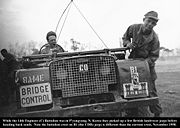

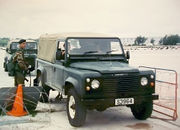
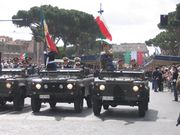
Various Land Rover models have been used in a military capacity, most notably by the British army. Modifications may include military "blackout" lightsinclude heavy duty suspension, uprated brakes, 24 volt electrics, convoy lights, electronic suppression of the ignition system, blackout curtains and mounts for special equipment and small arms. Dedicated military models have been produced such as the 101 Forward Control and the air-portable 1/2 ton Lightweight. Military uses include light utility vehicle; communications platform; weapon platform for recoilless rifles, Anti-Tank (e.g. TOW) / Surface-to-Air Guided Weapons ormachine guns; ambulances and workshops. The Discovery has also been used in small numbers, mostly as liaison vehicles.
Two models that have been designed for military use from the ground up are the 101 Forward Control from the early 1970s and the Lightweight or Airportable from the late 1960s. The latter was intended to be transported under a helicopter. The Royal Air Force Mountain Rescue Service (RAFMRS) teams were early users in the late 1950s and early 1960s, and their convoys of Land Rovers and larger military trucks are a sight often seen in the mountain areas of the United Kingdom. Originally RAFMRS Land Rovers had blue bodies and bright yellow tops, to be better seen from above. In 1981, the colour scheme was changed to green with yellow stripes. More recently, vehicles have been painted white, and are issued with fittings similar to civilian UK Mountain Rescue teams.
An adaptation of Land Rovers to military purposes is the "Pink Panther" models. Approximately 100 Series IIAs were adapted to reconnaissance use by the British special operations forces the SAS. For desert use they were often painted pink, hence the name. The vehicles were fitted with among other gear a sun compass, machine guns, larger fuel tanks and smoke dischargers. Similar adaptations were later made to Series IIIs and 90/110/Defenders.[25]
The 75th Ranger Regiment of the United States Army also adapted twelve versions of the Land Rover that were officially designated the RSOV (Ranger Special Operations Vehicle.)
Series and Defenders have also been uparmoured. The most widespread of these is the Shorts Shorland, built by Shorts Brothers of Belfast. The first of these were delivered in 1965 to the Royal Ulster Constabulary, the Northern Ireland police force. They were originally 109-inch (2,800 mm) wheelbase models with an armoured body and a turret from the Ferret armoured car. In 1990 there had been more than 1,000 produced.[26] In the 1970s a more conventional armoured Land Rover was built for the Royal Ulster Constabulary in Wales called the Hotspur. The Land Rover Tangi was built by the Royal Ulster Constabulary's own vehicle engineering team during the 1990s. The British Army has used various armoured Land Rovers, first in Northern Ireland but also in more recent campaigns. They first added protective panels to Series General Service vehicles (the Vehicle Protection Kit (VPK)). Later they procured the Glover Webb APV and finally the Courtaulds (later NP Aerospace) Composite Armoured Vehicle, commonly known as Snatch. These were originally based on heavy duty V8 110 chassis but some have recently been re-mounted on new chassis from Otokar of Turkey and fitted with diesel engines and air-conditioning for Iraq. Although these now have more in common with the 'Wolf' (Defender XD) Land Rovers that many mistakenly confuse them with, the Snatch and the Wolf are different vehicles.
The most radical conversion of a Land Rover for military purposes was the Centaur halftrack. It was based on a Series III with a V8 engine and a shortened belt drive from the Alvis Scorpion light tank. A small number was manufactured, and they were used by Ghana, among others.
The Land Rover is used by military forces throughout the world. However, it is increasingly being supplemented, and even replaced, by larger vehicles. For instance the Pinzgauer, now built in the UK, is increasingly common in roles previously the preserve of the Land Rover Defender, such as ambulances, artillery tractors and weapons platforms. This is mainly due to the demands of modern warfare- combat vehicles today are generally required to carry much more equipment in the form of weaponry, communications equipment and armour. A 'soft' light 4x4 like the traditional Land Rover simply does not have the load capacity or strength of a larger medium-duty vehicle like the Pinzgauer. Even the current generation of Land Rover used by the British Army, the Snatch 2, have upgraded and strengthened chassis and suspension compared to civilian-specification vehicles. There is also the Land Rover WMIK (weapon mounted installation kit) used by the British Army. The WMIK consists of a driver, a raised gun, usually a Browning heavy machine gun or a grenade machine gun, this used for ground support, and a GPMG (general purpose machine gunner) located next to the driver, this used for vehicle protection.
In competition
Highly modified Land Rovers have competed in the Paris Dakar Rally and won the Macmillan 4x4 UK Challenge almost every year, as well as having been the vehicle used for the Camel Trophy and more recently in the Odyssey Driving Around the World expedition series as part of a sponsorship deal. Now, Land Rover has its own G4 challenge.[27]
Driver training
Land Rover Experience was established in 1998, and consists of a network of centres throughout the world, set up to help customers get the most out of their vehicle's on and off-road capability. The flagship centre is based in Eastnor, Herefordshire in the UK, which has long been used as an engineering test and development facility. Courses offered include off-road driving, winching, and trailer handling, along with a variety of corporate and individual 'Adventure Days'. Land Rover Experience.
Safety
Road accident statistics on a model-by-model basis from the UK Department for Transport show that the Land Rover Defender is one of the safest cars on British roads, measured in terms of chance of death in two car injury accidents.[28] The figures, which were based on data collected by police forces following accidents between 2000 and 2004 in Great Britain, showed that Defender drivers had a 1% chance of being killed or seriously injured and a 33% chance of sustaining any kind of injury. Other four-wheel-drive vehicles scored equally highly, and collectively these vehicles were much safer than those in other classes such as passenger cars and MPVs. The figures acknowledge that drivers of large mass vehicles are likely to be safer, often at the expense of other drivers if they collide with smaller cars.
Quality
- Land Rover marque ranked last on the US J.D. Power and Associates Vehicle Dependability Survey for 2005 (published 8 July 2005) (Kia second last). This is the fourth year that it has been in the last or second to last place in the survey. This study was based on responses from more than 55,000 US based original owners of 2000 model year cars and light trucks at three years of ownership.[29] In 2004, it narrowly dethroned Kia as the least reliable nameplate, but swapped places in 2005. (Kia last, Land Rover 2nd last).
- In August 2006, Land Rover was rated in last place in the J.D. Power US reliability survey, which looked at three year ownership experience for 2003 model year cars.[30] Land Rover acknowledged the problems and attributed them to electrical issues following the change from BMW to Jaguar supplied engines.
- Tied for last (with Hummer and Porsche) in the 2006 Consumer Reports (US) car reliability survey. It was only one of six makes that did not have a model whose reliability was "Good" or above (joined by Mercedes-Benz, Volkswagen and Jaguar); its highest-rating car was the LR3, which got a rating of "Poor". In addition, 56 percent of people who owned a 2003 Range Rover reported problems, as did 61 percent of 2002 Freelander owners—both the highest among all cars for that model year.
- Ranked second-to-last in the 2007 Consumer Reports (US) car reliability survey. (Mercedes-Benz took the bottom place.) In the same survey, the LR3/Discovery with a V8 engine was ranked the second least reliable SUV in the midsized category. (The 2006 model year M-class of Mercedes-Benz took the last place in that category.)
- It also was ranked as one of the 3 least reliable over the last 10 years in 2007.[31]
- Land Rover Discovery 6th-from-the-bottom of 100 models for reliability in an Auto Express 2002 survey in the UK.
Clubs
There are many Land Rover clubs throughout the UK and internationally. Land Rover clubs break down into a number of groups of varying interests.
Single Marque Clubs - Bring together owners of a specific model or series of vehicle such as the Series One Club,[32] or the Discovery Owners Club.[33] Clubs based on ownership of earlier series vehicles tend to attract the purists amongst Land Rover owners whose interests often relate to restoration of their vehicles to their original condition.
Special Vehicle Clubs - At various times Land Rover have produced vehicles for specific events or on a specific theme, most notable are the Camel Trophy and G4 Challenge vehicles which have been sold on to the general public, and a range of Defenders that were loosely based on the custom vehicles produced for the Tomb Raider motion picture.
Regional Clubs - These break down into two groups, competitive and non-competitive clubs.
Non-competitive clubs activities generally relate to social events, off road driving or green laning on un-surfaced public highways or 'pay and play' days at off road centres.
Competitive clubs are a phenomenon almost exclusively found within the UK, who as well as the non-competitive activities detailed above run competitive events such as Tyro, Road Taxed Vehicle (RTV) and Cross Country Vehicle (CCV) trials, winch and recovery challenges or speed events such as Competitive Safari's. All UK competitive events are run within the framework of rules created by the Motor Sports Association (MSA) with further vehicle specific rules applied by the host club or association.
A number of clubs are affiliated to the Association of Land Rover Clubs[34] (ALRC) formerly known as the Association of Rover Clubs (ARC) the association applies its own vehicle regulations to all of its member clubs who have the opportunity to compete together at regional events and an annual national event with vehicles approved to the same standard.
Club Licensing - In 2005 under Ford ownership the Land Rover company became more interested in the club environment. An internal club was formed, The Land Rover Club[35] a club exclusive to employees of the Ford Premier Automotive Group (Now exclusive to the new 'Jaguar - Land Rover' group since the brand moved away from the Ford stable). Also, an agreement was generated to allow other clubs to use the Land Rover green oval logo under licence. In 2006 the Bedfordshire, Hertfordshire and Cambridgeshire [36] club were the pilot licensees for the new agreement, who now benefit from a reciprocal arrangement where their own logo is trade marked[37] and owned by Land Rover and they can refer to themselves as a 'Land Rover Approved Club'.
Bicycles and pushchairs
In 1995 Land Rover endorsed the production of a hand-made bicycle using its logo. The bicycle was called the Land Rover APB and was manufactured by Pashley Cycles, of Stratford-upon-Avon, being the collapsible version of their Moulton designed APB (All Purpose Bicycle) model with leading link front suspension with adjustable damping and stroke. It was available in Golden Yellow with Green lettering or British Racing Green with yellow lettering colour scheme. Two more models immediately followed the Land Rover XCB V-20 and was aimed primarily at younger riders (children) and the Land Rover XCB D-26, also available as the M26 being one of the first bicycles offered with hydraulic rim brakes, front suspension and suspension seat pillar.
In June 2004 Land Rover released a comprehensive 25 model range of bicycles to complement the automotive range. The three main ranges are the 'Defender' the 'Discovery' and the 'Freelander'. Each range has its different attributes. The 'Discovery' is an all-rounder bicycle and is suited to a mixture of different terrains. The 'Defender' range is most suited to rugged terrain and off road pursuits, whereas the 'Freelander' is designed for an urban lifestyle. All bikes are made from lightweight aluminium and cost from £200-£900.
Land Rover gave UK pram company Pegasus a license to produce a three-wheeler range of Land Rover ATP pushchairs. The design reflected the heritage of the marque, with a light metal frame with canvas seating, held together with push-studs and tough simple parts like brakes and hinges. They could be collapsed completely flat, with wheels removed in seconds. The basic frame could be adapted with modules to allow a baby to lie flat or a bubble windscreen to completely enclose the child. The frame also came in long or short-handled versions, and could be repaired with home tools. The design was simple, light, and rugged and able to travel in all terrains (hence the ATP for all-terrain pushchair.) It came in three military looking colours: a light blue, a sand colour and olive drab. Production was discontinued in 2002. [38]
See also
- Land Rover Series
- Defender
- Range Rover
- Range Rover Sport
- Discovery
- Freelander
- Camel Trophy
- G4 Challenge
- Criticism of sport utility vehicles
- Land Rover Our Planet Programme
References
- ↑ Graham Robson (1981). The Rover company (2 ed.). Patrick Stephens. ISBN 0850595436.
- ↑ "Joint Venture, Subsidiary and Associate Companies: Jaguar Land Rover". Tata Motors. http://www.tatamotors.com/our_world/associates00.php?PageID=13. Retrieved 27 July 2010.
- ↑ 3.0 3.1 3.2 Ford Motor Company (2008-03-26). "Ford Motor Company Announces Agreement to Sell Jaguar Land Rover to Tata Motors". Press release. http://media.ford.com/newsroom/release_display.cfm?release=27953. Retrieved 2008-03-27.
- ↑ Tata Motors (2008-03-26). "Tata Motors enters into Definitive Agreement with Ford for purchase of Jaguar Land Rover". Press release. http://www.tatamotors.com/our_world/press_releases.php?ID=356&action=Pull. Retrieved 2008-03-27.
- ↑ 5.0 5.1 5.2 "Tata Motors completes acquisition of Jag, Land Rover". Thomson Reuters. 2 June 2008. http://www.reuters.com/article/ousiv/idUSBMA00084220080602. Retrieved 2008-06-02.
- ↑ Article on page M5 of The Daily Telegraph entitled "The sands of time" by Kevin Hackett about Wilks' prototype (Issue 47,531, dated 29th March 2008)
- ↑ "net report that 75% of Land Rovers ever built are still in use". Landroverclub.net. http://www.landroverclub.net. Retrieved 2010-07-15.
- ↑ Forbes India's Tata confirms interest in Land Rover, Jaguar
- ↑ CNN India's Tata eyeing Jaguar and Land Rover
- ↑ 17:15 24 Aug 2006 By Neil Gerrard (2006-08-24). "JCB's Sir Anthony Bamford eyes Jaguar - 24/08/2006". Contract Journal. http://www.contractjournal.com/Articles/2006/08/24/51974/jcbs-sir-anthony-bamford-eyes-jaguar.html. Retrieved 2010-07-15.
- ↑ 16:19 16 Oct 2006 By Neil Gerrard (2006-10-16). "JCB will not buy Jaguar - 16/10/2006". Contract Journal. http://www.contractjournal.com/Articles/2006/10/16/52516/jcb-will-not-buy-jaguar.html. Retrieved 2010-07-15.
- ↑ "Tata set to clinch the Jaguar-Land Rover deal: Report". Press Trust of India. 2007-12-20. http://timesofindia.indiatimes.com/Tata_set_to_clinch_Jaguar-Land_Rover_deal_Report/articleshow/2637533.cms. Retrieved 2007-12-20.
- ↑ "Ford set to pick Jaguar frontrunner in days: source". Reuters. 2007-12-17. http://www.washingtonpost.com/wp-dyn/content/article/2007/12/17/AR2007121700620.html. Retrieved 2007-12-18.
- ↑ "5 for 2 special: Tata acquires 3 other British marques in Jaguar, Land Rover deal". Leftlane News. 28 March 2008. http://www.leftlanenews.com/5-for-2-special-tata-acquires-3-other-british-marques-in-jaguar-land-rover-deal.html#more-6922. Retrieved 2008-03-28.
- ↑ Land Rover. "Sixty Years and Four Million Vehicles: Milestones of Land Rover's History". Press release. http://uk.medialandrover.com/uploads/pdf/sixty_year_anniversary_timeline_4cd8.doc. Retrieved 2008-04-06.
- ↑ "BMW, Ford seal Land Rover deal". BBC News. 2000-05-24. http://news.bbc.co.uk/2/hi/business/761794.stm. Retrieved 2010-05-07.
- ↑ "India's Tata confirms interest in Land Rover, Jaguar". Forbes.com. 2007-08-24. http://www.forbes.com/markets/feeds/afx/2007/08/24/afx4052453.html. Retrieved 2010-07-15.
- ↑ geocites.com guide to Land Rover
- ↑ 19.0 19.1 Rothwell, Steven; Nair, Vipin V. (28 May 21010). "Tata Motors Plans to Build Jaguar, Land Rover Models in China". Business Week. http://www.businessweek.com/news/2010-05-28/tata-motors-plans-to-build-jaguar-land-rover-models-in-china.html. Retrieved 27 July 2010.
- ↑ 20.0 20.1 "Land Rover Announces Diesel ERAD Hybrid & e_Terrain Technologies". Worldcarfans. http://www.worldcarfans.com/9080722.009/land-rover-announces-diesel-erad-hybrid--e_terrain-technologies. Retrieved 2009-06-19.
- ↑ "Factory News". Roversnorth.com. http://www.roversnorth.com/weblog/?p=42. Retrieved 2009-06-19.
- ↑ "Land Rover presents ERAD diesel-hybrid prototypes - MotorAuthority - Car news, reviews, spy shots". MotorAuthority. 2008-07-22. http://www.motorauthority.com/land-rover-presents-erad-diesel-hybrid-prototypes.html. Retrieved 2009-06-19.
- ↑ "Land Rover Working On Diesel Erad Hybrid And E_Terrain Technologies". cubi[CC]apacity. http://www.cubiccapacity.com/land-rover-working-diesel-erad-hybrid-and-e_terrain-technologies/. Retrieved 2009-06-19.
- ↑ "Land Rover unveils eco-car / How To Save Energy / Daily news / Resources / Home". Energy Saving Trust. http://www.energysavingtrust.org.uk/content/view/full/20388/resources. Retrieved 2009-06-19.
- ↑ Bob Morrison: Land Rovers in military service, Brooklands Books 1993, ISBN 1-85520-205-0
- ↑ "Shorland.info". Shorland.info. http://www.shorland.info/articles/clive001.html. Retrieved 2010-07-15.
- ↑ "Land Rover International - Latest News - Corporate News". Landroverg4challenge.com. 2009-03-11. http://www.landroverg4challenge.com. Retrieved 2009-06-19.
- ↑ "Cars: make and model: the risk of driver injury in GB: 2000-2004". Department for Transport. 12 October 2006. http://www.dft.gov.uk/pgr/statistics/datatablespublications/vehicles/carsmmrisk/carsmakeandmodeltheriskofdri1800. Retrieved 28 July 2009.
- ↑ [1]
- ↑ "Land Rover comes bottom in J.D. Power US reliability survey". Auto Industry. 10 August 2006. http://www.autoindustry.co.uk/news/10-08-06_14.
- ↑ "Most & least reliable brands - 950,000 readers tell which products really last", Consumer Reports, May 2007, p. 12
- ↑ "Land Rover Series One Club website". Lrsoc.demon.co.uk. http://www.lrsoc.demon.co.uk. Retrieved 2010-07-15.
- ↑ "Discovery Owners' Club website". Discoveryownersclub.org. http://www.discoveryownersclub.org. Retrieved 2010-07-15.
- ↑ "Association of Land Rover Clubs website". Alrc.co.uk. http://www.alrc.co.uk. Retrieved 2010-07-15.
- ↑ "Land Rover Club website". Landroversclub.org. http://www.landroversclub.org. Retrieved 2010-07-15.
- ↑ "Beds, Herts & Cambs Land Rover Club website". Bhclrc.co.uk. http://www.bhclrc.co.uk. Retrieved 2010-07-15.
- ↑ "IPO UK". Ipo.gov.uk. http://www.ipo.gov.uk/tm/t-find/t-find-number?detailsrequested=C&trademark=2402968. Retrieved 2010-07-15.
- ↑ "Land Rover Pushchairs Online". Landroverpushchairs.co.uk. http://www.landroverpushchairs.co.uk/acatalog/index.html. Retrieved 2010-07-15.
External links
- Official Land Rover Website
- Land Rover YouTube channel
- Land Rover and Land Rover clubs at the Open Directory Project
- Land Rover VIN codes on Wikibooks
- Land Rover at the Internet Movie Cars Database
|
|||||||||||||||||||||||||||||
| Marque | 1900s | 1910s | 1920s | 1930s | 1940s | 1950s | 1960s | 1970s | 1980s | 1990s | 2000s | 2010s | ||||||||||||||||||||||||||||||||||||||||||||||||
|---|---|---|---|---|---|---|---|---|---|---|---|---|---|---|---|---|---|---|---|---|---|---|---|---|---|---|---|---|---|---|---|---|---|---|---|---|---|---|---|---|---|---|---|---|---|---|---|---|---|---|---|---|---|---|---|---|---|---|---|---|
| Rolls-Royce | Rolls-Royce Limited | Rolls-Royce Limited & Bentley | Rolls-Royce Motors | Rolls-Royce Motors (Vickers) | BMW & VW Group | BMW | ||||||||||||||||||||||||||||||||||||||||||||||||||||||
| Bentley | Bentley | Volkswagen Group | ||||||||||||||||||||||||||||||||||||||||||||||||||||||||||
| Armstrong Siddeley | Siddeley-Deasy | Armstrong Whitworth | Armstrong Siddeley | Bristol Siddeley | Rolls-Royce Limited | Rolls-Royce plc | ||||||||||||||||||||||||||||||||||||||||||||||||||||||
| Aston Martin | Aston Martin | Aston Martin Lagonda | Ford PAG | Aston Martin Lagonda | ||||||||||||||||||||||||||||||||||||||||||||||||||||||||
| Lagonda | Lagonda | |||||||||||||||||||||||||||||||||||||||||||||||||||||||||||
| Jaguar | SS Cars | Jaguar | Jaguar & Daimler |
BMH | BLMC / British Leyland | Jaguar & Daimler |
Ford PAG | Tata | ||||||||||||||||||||||||||||||||||||||||||||||||||||
| Daimler | Daimler | BSA | BSA | |||||||||||||||||||||||||||||||||||||||||||||||||||||||||
| Lanchester | Lanchester | |||||||||||||||||||||||||||||||||||||||||||||||||||||||||||
| Rover | Rover | Rover | Rover | Austin Rover Group & Land Rover Group (BL plc) |
Rover Group (BAe) | Rover Group (BMW) |
MG Rover Group (PVH) | |||||||||||||||||||||||||||||||||||||||||||||||||||||
| Land Rover | Ford PAG | |||||||||||||||||||||||||||||||||||||||||||||||||||||||||||
| Alvis | Alvis | BAE Systems | ||||||||||||||||||||||||||||||||||||||||||||||||||||||||||
| Standard | Standard | Standard Triumph | Leyland Motors | British Motor Heritage | ||||||||||||||||||||||||||||||||||||||||||||||||||||||||
| Triumph | Dawson | Triumph | BMW | |||||||||||||||||||||||||||||||||||||||||||||||||||||||||
| Riley | Riley | Nuffield Organisation | BMC | BMH | ||||||||||||||||||||||||||||||||||||||||||||||||||||||||
| MG | Morris Garages (MG) | Rover Group (BMW) |
MG Rover Group (PVH) | SAIC & NAC |
SAIC | |||||||||||||||||||||||||||||||||||||||||||||||||||||||
| Morris | Morris | Morris | ||||||||||||||||||||||||||||||||||||||||||||||||||||||||||
| Wolseley | Wolseley | |||||||||||||||||||||||||||||||||||||||||||||||||||||||||||
| Austin | Austin | Austin | ||||||||||||||||||||||||||||||||||||||||||||||||||||||||||
| Vanden Plas | Vanden Plas | |||||||||||||||||||||||||||||||||||||||||||||||||||||||||||
| Mini | Mini (BMW) | |||||||||||||||||||||||||||||||||||||||||||||||||||||||||||
| Austin-Healey | Austin (BMC) & Donald Healey | |||||||||||||||||||||||||||||||||||||||||||||||||||||||||||
| Jensen | Jensen Motors | Britcar Holdings | Jensen Cars | |||||||||||||||||||||||||||||||||||||||||||||||||||||||||
| Reliant | Reliant | Reliant | ||||||||||||||||||||||||||||||||||||||||||||||||||||||||||
| Bond | Bond | |||||||||||||||||||||||||||||||||||||||||||||||||||||||||||
| AC | AC Cars (several ownership & company name changes) | |||||||||||||||||||||||||||||||||||||||||||||||||||||||||||
| Argyll | Argyll | Argyll | ||||||||||||||||||||||||||||||||||||||||||||||||||||||||||
| Bristol Cars | Bristol Cars | |||||||||||||||||||||||||||||||||||||||||||||||||||||||||||
| Caterham | Caterham | |||||||||||||||||||||||||||||||||||||||||||||||||||||||||||
| Crossley | Crossley | |||||||||||||||||||||||||||||||||||||||||||||||||||||||||||
| Dutton | Dutton | Dutton | ||||||||||||||||||||||||||||||||||||||||||||||||||||||||||
| Ginetta | Ginetta | |||||||||||||||||||||||||||||||||||||||||||||||||||||||||||
| Gordon-Keeble | Peerless & Warwick | Gordon-Keeble | ||||||||||||||||||||||||||||||||||||||||||||||||||||||||||
| Jowett | Jowett | Blackburn | ||||||||||||||||||||||||||||||||||||||||||||||||||||||||||
| Lea-Francis | Lea-Francis | |||||||||||||||||||||||||||||||||||||||||||||||||||||||||||
| Lotus | Lotus | General Motors Europe | Proton | |||||||||||||||||||||||||||||||||||||||||||||||||||||||||
| McLaren | McLaren | |||||||||||||||||||||||||||||||||||||||||||||||||||||||||||
| Marcos | Marcos | Marcos | Marcos | |||||||||||||||||||||||||||||||||||||||||||||||||||||||||
| Morgan | Morgan | |||||||||||||||||||||||||||||||||||||||||||||||||||||||||||
| Napier | Napier | |||||||||||||||||||||||||||||||||||||||||||||||||||||||||||
| Turner | Turner | |||||||||||||||||||||||||||||||||||||||||||||||||||||||||||
| TVR | TVR | |||||||||||||||||||||||||||||||||||||||||||||||||||||||||||
| Westfield | Westfield | Potenza Sports Cars | ||||||||||||||||||||||||||||||||||||||||||||||||||||||||||
| GTM | GTM | |||||||||||||||||||||||||||||||||||||||||||||||||||||||||||
| Vauxhall | Vauxhall Motors | General Motors | General Motors Europe | |||||||||||||||||||||||||||||||||||||||||||||||||||||||||
| Vulcan | Vulcan | |||||||||||||||||||||||||||||||||||||||||||||||||||||||||||
| Hillman | Hillman | Humber | Rootes | Chrysler Europe (Chrysler) | Peugeot (PSA) | |||||||||||||||||||||||||||||||||||||||||||||||||||||||
| Humber | Humber | |||||||||||||||||||||||||||||||||||||||||||||||||||||||||||
| Singer | Singer | Rootes | ||||||||||||||||||||||||||||||||||||||||||||||||||||||||||
| Sunbeam | Sunbeam | Sunbeam-Talbot-Darracq | Rootes | (as Sunbeam-Talbot) Rootes | Rootes | |||||||||||||||||||||||||||||||||||||||||||||||||||||||
| Talbot | Talbot | |||||||||||||||||||||||||||||||||||||||||||||||||||||||||||
| Marque | 1900s | 1910s | 1920s | 1930s | 1940s | 1950s | 1960s | 1970s | 1980s | 1990s | 2000s | 2010s | ||||||||||||||||||||||||||||||||||||||||||||||||
| Marque | 1900s | 1910s | 1920s | 1930s | 1940s | 1950s | 1960s | 1970s | 1980s | 1990s | 2000s | 2010s | |||||||||||||||||||||||||||||||||||||||||||||||||
|---|---|---|---|---|---|---|---|---|---|---|---|---|---|---|---|---|---|---|---|---|---|---|---|---|---|---|---|---|---|---|---|---|---|---|---|---|---|---|---|---|---|---|---|---|---|---|---|---|---|---|---|---|---|---|---|---|---|---|---|---|---|
| Jaguar | SS Cars | Jaguar | Jaguar & Daimler |
BMH | BLMC / British Leyland | Jaguar & Daimler |
Ford PAG | Tata | |||||||||||||||||||||||||||||||||||||||||||||||||||||
| Daimler | Daimler | BSA | BSA | ||||||||||||||||||||||||||||||||||||||||||||||||||||||||||
| Lanchester | Lanchester | ||||||||||||||||||||||||||||||||||||||||||||||||||||||||||||
| Rover | Rover | Rover | Rover | Austin Rover Group & Land Rover Group (BL plc) |
Rover Group (BAe) | Rover Group (BMW) |
MG Rover Group (PVH) | ||||||||||||||||||||||||||||||||||||||||||||||||||||||
| Land Rover | Ford PAG | ||||||||||||||||||||||||||||||||||||||||||||||||||||||||||||
| Alvis | Alvis | BAE Systems | |||||||||||||||||||||||||||||||||||||||||||||||||||||||||||
| Standard | Standard | Standard Triumph | Leyland Motors | British Motor Heritage | |||||||||||||||||||||||||||||||||||||||||||||||||||||||||
| Triumph | Dawson | Triumph | BMW | ||||||||||||||||||||||||||||||||||||||||||||||||||||||||||
| Riley | Riley | Nuffield Organisation | BMC | BMH | |||||||||||||||||||||||||||||||||||||||||||||||||||||||||
| MG | Morris Garages (MG) | Rover Group (BMW) |
MG Rover Group (PVH) | SAIC & NAC |
SAIC | ||||||||||||||||||||||||||||||||||||||||||||||||||||||||
| Morris | Morris | Morris | |||||||||||||||||||||||||||||||||||||||||||||||||||||||||||
| Wolseley | Wolseley | ||||||||||||||||||||||||||||||||||||||||||||||||||||||||||||
| Austin | Austin | Austin | |||||||||||||||||||||||||||||||||||||||||||||||||||||||||||
| Vanden Plas | Vanden Plas | ||||||||||||||||||||||||||||||||||||||||||||||||||||||||||||
| Mini | Mini (BMW) | ||||||||||||||||||||||||||||||||||||||||||||||||||||||||||||
| Austin-Healey | Austin (BMC) & Donald Healey | ||||||||||||||||||||||||||||||||||||||||||||||||||||||||||||
| Marque | 1900s | 1910s | 1920s | 1930s | 1940s | 1950s | 1960s | 1970s | 1980s | 1990s | 2000s | 2010s | |||||||||||||||||||||||||||||||||||||||||||||||||
|
|||||||||||||||||||||||||||||||||||||||||||||||
| Type | 1940s | 1950s | 1960s | 1970s | 1980s | 1990s | 2000s | 2010s | ||||||||||||||||||||||||||||||||||||||||||||||||||||||||||
| 5 | 6 | 7 | 8 | 9 | 0 | 1 | 2 | 3 | 4 | 5 | 6 | 7 | 8 | 9 | 0 | 1 | 2 | 3 | 4 | 5 | 6 | 7 | 8 | 9 | 0 | 1 | 2 | 3 | 4 | 5 | 6 | 7 | 8 | 9 | 0 | 1 | 2 | 3 | 4 | 5 | 6 | 7 | 8 | 9 | 0 | 1 | 2 | 3 | 4 | 5 | 6 | 7 | 8 | 9 | 0 | 1 | 2 | 3 | 4 | 5 | 6 | 7 | 8 | 9 | 0 | |
| Off-road vehicle | Series I | Series II | Series III | |||||||||||||||||||||||||||||||||||||||||||||||||||||||||||||||
| Ninety & One Ten | Defender | |||||||||||||||||||||||||||||||||||||||||||||||||||||||||||||||||
| Mid-size SUV | Range Rover Classic | |||||||||||||||||||||||||||||||||||||||||||||||||||||||||||||||||
| Full-size SUV | Range Rover | Range Rover | Range Rover | |||||||||||||||||||||||||||||||||||||||||||||||||||||||||||||||
| Mid-size SUV | Discovery Series I | Discovery Series II | Discovery 3 | Discovery 4 | ||||||||||||||||||||||||||||||||||||||||||||||||||||||||||||||
| Compact SUV | Freelander | Freelander 2 | ||||||||||||||||||||||||||||||||||||||||||||||||||||||||||||||||
| Full-size SUV | Range Rover Sport | |||||||||||||||||||||||||||||||||||||||||||||||||||||||||||||||||
|
|||||||||||||
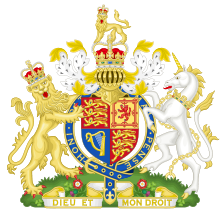
.svg.png)

